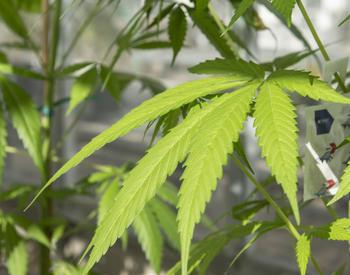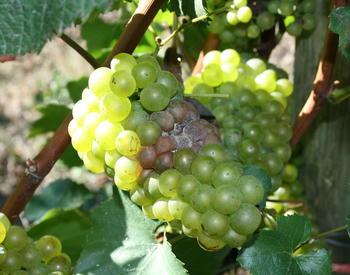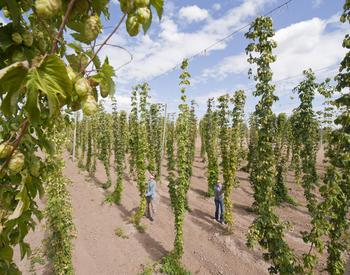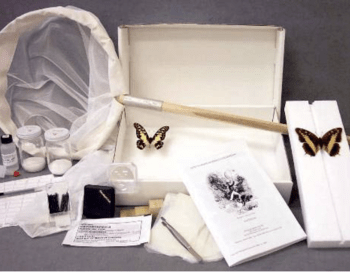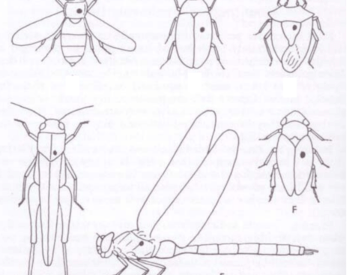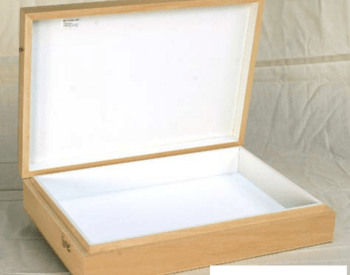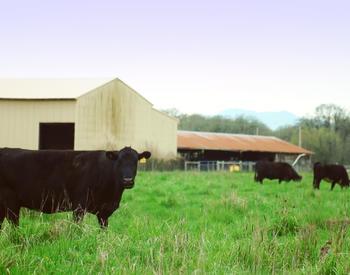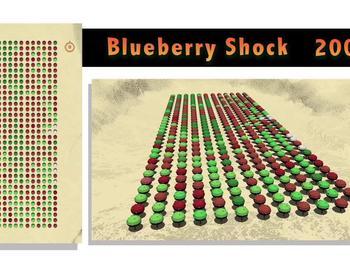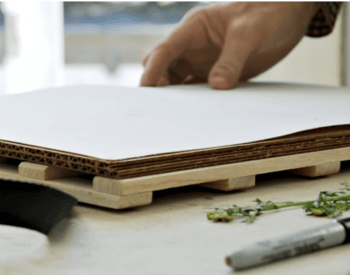When the field season draws to a close for Oregon hemp growers, any change to moist, cooler weather could bring on disease problems caused by Sclerotinia sclerotiorum (hemp canker) and Botrytis cinerea (gray mold, or Botrytis bud blight and stem canker). Both of these fungal diseases result in stem cankers and bud infections in hemp.
The diseases begin with the appearance of water-soaked lesions on leaves, buds or both. Weak tissues, such as flower buds and senescing leaves, are susceptible to infection. After successful infection, the fungi grow into healthy plant portions and may invade the stem portion near infected buds, thereby causing the death of the upper shoot portion. Cankers can develop lower on plant stems, too. Eventually, infected buds turn brown as tissues die.
Stem cankers are typically lighter in color than healthy stem portions. Sclerotinia-infected stems and buds are whitish in appearance due to the production of fluffy, white-colored mycelium (Fig. 1), while Botrytis-infected hemp buds have grayish-colored mycelium on infected bud or stem portions (Fig. 2). Also, Sclerotinia-infected buds frequently have sclerotia embedded in them, both internally and on external surfaces. Newly forming sclerotia are white in coloration and darken (Fig.1) as they mature.
In Oregon, both hemp canker and gray mold fungi are found in field-grown hemp plants. These pathogens have a broad host range. Other susceptible host plants include beans, potatoes and other vegetables, as well as certain fruit crops, seed crops, herbs and a large number of woody and herbaceous ornamentals. Weeds are also hosts for Sclerotinia sclerotium. For example, dandelion (Taraxacum officinale) is a very susceptible weed host.
Sclerotinia sclerotiorum survives as sclerotia, which may be associated with infected plant residues contained in seed lots (external or internal to seed) or persist in the soil. Sclerotia are small, compact, hardened masses of hyphae and can survive three years or longer in the soil, depending on environmental conditions and cropping practices. Sclerotia germinate within a half inch of the soil surface and produce a small, stalked, cup-shaped fruiting structure known as an apothecium. This fruiting structure forcibly ejects millions of ascospores into the air that can then move on wind currents.
For infection, ascospores require free moisture or a relative humidity close to 100% with a temperature between 50°F and 86°F. Botrytis requires similar moist conditions for infection and also may produce sclerotia. But sclerotia are not necessary for Botrytis to survive. Botrytis occurs on a large number of plant hosts throughout the year, producing asexual spores (conidia) that can be wind-blown to susceptible plants during most months. Moist conditions within the plant canopy favor infection by either of these fungi, as do rain, dew or irrigation practices that keep foliage wet for long periods. Rainy periods during bud maturation can bring on large disease outbreaks in hemp.
Recommended management
For hemp canker and gray mold, recommended management includes cultural control practices to improve air circulation and minimize leaf wetness, such as plant spacing, pruning of the plants and irrigation timing. If Sclerotinia is detected, it is recommended that growers remove and destroy infected plant portions when possible. Rotate with nonhosts for eight years to achieve the best control of Sclerotinia, but for at least two years to reduce the population of sclerotia; grasses and cereals are not affected by sclerotinia.
Contans WG, which has an Organic Materials Review Institute certification for organic production, can be used as a preplant or postharvest soil application and will help to reduce the survival of sclerotia produced by Sclerotinia. For the management of Botrytis, LifeGard WG, Regalia and Stargus are possible options. A field trial conducted by OSU in 2020 showed that Stargus at 2 quarts per acre on a weekly interval during bud development reduced Botrytis incidence and severity on hemp compared to nontreated plants (Table 1). Additional fungicide and biocontrol options are listed in the Oregon Department of Agriculture hemp pesticide guide list.
| % of plants with Botrytisz | % of Botrytis-infected buds present in 1-ft portionsz | ||||
|---|---|---|---|---|---|
| Treatment (rate)y | 25 Sep | 2 Oct | 9 Oct | Treatment averagex | 9 Octw |
| Nontreated control | 15.5 | 38.0 | 83.0 | 45.1 A | 14.9 A |
| Botrystop (3 lb/a) | 7.5 | 22.5 | 59.0 | 24.5 B | 6.7 B |
| Stargus (2 qt/a) | 8.0 | 30.0 | 58.0 | 27.1 B | 6.5 B |
| Stargus (4 qt/a) | 10.0 | 18.0 | 55.5 | 23.8 B | 7.1 B |
| Average datex | 9.9 a | 26.5 b | 65.1 c | ||
From: Bates, T.A., M. Dietrich, and C.M. Ocamb. 2021. Evaluation of biofungicides for gray mold on hemp in Oregon, 2020. Plant Dis. Manage. Rep.: Rep. No. 15:V048.
z Visual evaluations of disease incidence in the uppermost 1-foot portion of eight individual inflorescences on each of five randomly chosen plants in each plot were made on Sept. 25, Oct. 2 and Oct. 9 2020.
y Applications were made on Aug. 25, Sept. 1, Sept. 16, Sept. 22, Sept. 29 and Oct. 6 2020
x Means within a column or row followed by the same letter are not significantly different based on a generalized linear mixed effects model and pairwise t-test at P≤0.05.
w Means within a column followed by the same letter are not significantly different based on a linear mixed effect model and pairwise t-test at P≤0.05.
Use pesticides safely!
- Wear protective clothing and safety devices as recommended on the label. Bathe or shower after each use.
- Read the pesticide label—even if you’ve used the pesticide before. Follow closely the instructions on the label (and any other directions you have).
- Be cautious when you apply pesticides. Know your legal responsibility as a pesticide applicator. You may be liable for injury or damage resulting from pesticide use.
